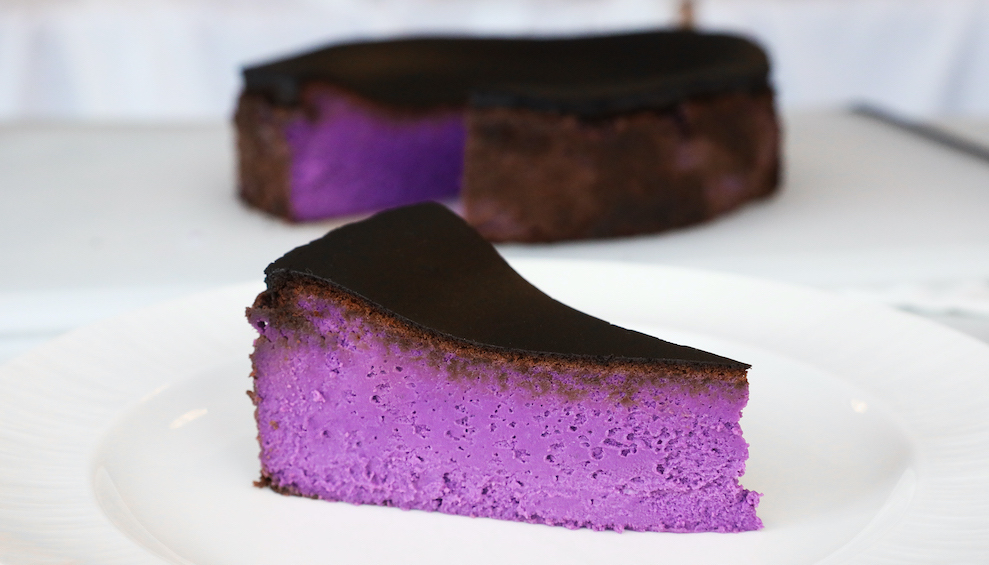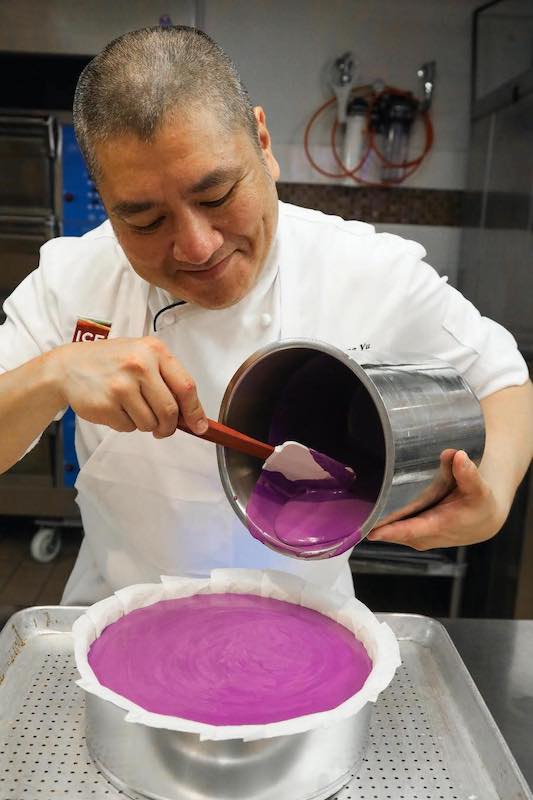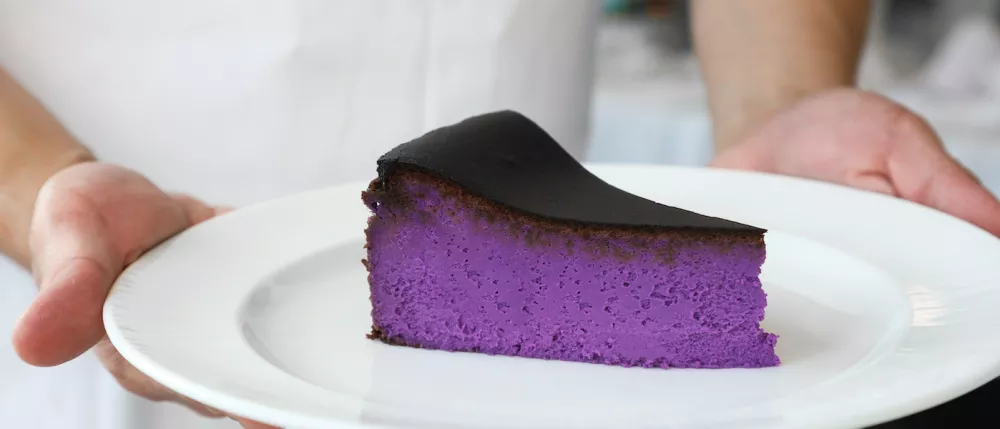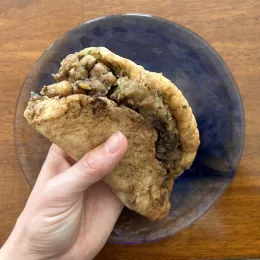This vibrant cake's gorgeous hue is sure to please a crowd.
Basque cheesecakes are enjoying the spotlight on social media right now. Their reach runs the gamut, with flavors ranging from traditional to experimental, including Thai milk tea, espresso-chocolate and everything in between.
"This style of cheesecake comes from the Basque region of Spain, with its most distinctive features being a deeply burnt top, a creamy interior and no separate graham cracker crust, as is common with American or New York-style cheesecakes," Pastry & Baking Arts Chef-Instructor Trung Vu says.
After he wowed us with the colors of his rainbow crêpe cake, we asked Chef Trung to take the Basque cheesecake up a notch and flavor it with ube. The plan was a cheesecake with a dark brown, burnt top and a soft, purple, custardy interior.
Did he succeed? Yes, with flying colors. How’d he do it? Read on to find out.

How to Adjust a Recipe
Chef Trung used a Basque cheesecake recipe from former Pastry & Baking Arts Chef-Instructor Eric McIntyre as the starting point for his recipe testing.
He followed the recipe and baked the cheesecake to evaluate it as is (spoiler alert, it’s delicious). Happy with the recipe, Chef Trung chose not to adjust it too much with the exception of adding ube flavor.
Chef Trung converted all of the recipe’s measurements into grams so he could understand the relationship between the ingredients and easily manipulate them.
Baker’s Percentages
After testing Chef Eric’s cheesecake, Chef Trung researched other recipes to get a sense of how much ube can be incorporated. To do this, he calculated the baker’s percentages or the ratio of the ingredients to the dominant ingredient.
In this case, the dominant ingredient is cream cheese, because there is more cream cheese than any other ingredient. (Baker’s percentages are yet another reason why it’s imperative to measure by weight rather than by volume.)
For example, using the recipe below, divide the weight of the sugar by the cream cheese, then multiply by 100. So, (367g sugar/1221g cream cheese) x 100 = 30%, which is the percent of sugar in relation to the total weight of the cream cheese.
According to Chef Trung, “baker’s percentages enable chefs to modify ingredient quantities without changing the whole recipe, and with a lot of experience, help us predict what the finished product will be like.”
It’s important to note that baker’s percentages are a fraction of the dominant ingredient, meaning if you add them up, it will not equal 100%. The cream cheese is the dominant ingredient here so it will be 100%.
Baker’s percentages are often used in bread baking where flour is the dominant ingredient, and students in Pastry & Baking Arts and Artisan Bread Baking practice manipulating ingredients using the formula.
Percentages in Practice: All About Cake Math
Recipe Testing
In his research, Chef Trung found that cheesecake recipes have between 13-20% ube in relation to the total cream cheese. He made the Basque cheesecake again, incorporating ube halaya jam at 13% to test the flavor.
But Chef Trung wasn’t satisfied with the amount of ube coming through in the final product, so he upped the ube to 20%.
"This yielded an interesting and evolving flavor profile where cream cheese is still at the forefront, but after a moment on the palate, the ube flavor comes through and lingers," Chef Trung says. "I really enjoy when flavors are balanced but also dynamic. It makes things fun to eat."

When recipe testing, Chef Trung warns against making too many changes at once.
“Only change one element at a time, or it will be difficult to determine what’s causing a specific result,” he says.
It’s not easy to find fresh ube in New York City, so Chef Trung also experimented with different methods of adding ube flavor to the cheesecake.
After testing a few brands, he settled on ube jam to bring the natural ube flavor as well as ube extract for its concentrated flavor and color.
If you’d like to explore more with ube, Chef Trung thinks ube ice cream or an ube pie in the style of sweet potato pie would be delicious. Or, try this recipe for ube-flavored Portuguese custard tarts from Art of Cake Decorating Chef-Instructor Penny Stankiewicz.
Check out Chef Trung's final recipe below. Happy baking!

Ingredients
- 253 grams ube halaya jam
- 367 grams sugar
- 1221 grams cream cheese, softened
- 2 vanilla beans (alternatively, 1 1/2 teaspoons vanilla extract)
- 272 grams sour cream (or crème fraîche)
- 300 grams of eggs (about 6 eggs)
- 80 grams egg yolks (about 4 egg yolks)
- 30 grams all-purpose flour
- 1 tablespoon and 1 teaspoon ube extract
Directions
- Preheat oven to 450°F.
- Line a 9.5”x3" springform pan with parchment paper so that the parchment covers the surface area of the interior and hangs up and over the sides. Place the lined pan onto a sheet tray and set aside.
- In the bowl of stand mixer, cream ube jam and sugar until incorporated, using the paddle attachment.
- Add the cream cheese and continue to cream until the mixture is smooth, homogenous and free of lumps. Occasionally scrape down the sides of the bowl with a rubber spatula.
- Split and scrape the vanilla beans into the batter. Blend until incorporated.
- Add the sour cream and mix.
- Add the eggs and yolks, one at a time, allowing each addition to incorporate.
- Add the flour, blend thoroughly.
- Add the ube extract and mix until incorporated.
- Strain the mixture through a sieve to remove any chunks of cream cheese that were not incorporated.
- Pour into springform pan and bake until the cheesecake reaches an internal temperature of about 160°F when tested with a probe thermometer (about one hour).
- Remove from oven and allow to cool in the pan at room temperature for at least two hours.
- Refrigerate for at least four hours or preferably overnight before serving.






